Hydro Nation: annual report 2021
Records the development of Scotland's Hydro Nation policy agenda and reports on progress since the publication of the seventh annual report in 2020.
Promoting growth and innovation in the water sector
Scottish Water's route to net-zero
Net Zero Emissions Routemap
Scottish Water's Net Zero Emissions Routemap was published on 14 September 2020 with an update on progress in September 2021. It is one of the most ambitious plans in the industry due to its scope and scale. It targets operational emissions which are under their control, as well as those emissions embedded in investment programmes and supply chains which they have influence over. It is a genuine net zero plan which does not include the purchase of carbon credits.
The Routemap explains how Scottish Water will reduce its emissions, embrace the circular economy and enhance the natural environment. Through this they will maximise their contribution to renewable energy generation by supporting the greening of the grid and increasing their ability to capture and store emissions in their land.
By the end of 2027, Scottish Water will be 35% through the timeline to their target, emphasising the need to change behaviours and processes at pace. In recognition of this, they have developed an ambitious target to achieve net zero operational emissions by 2030, 10 years ahead of the overall net zero emissions target of 2040.
Peatland Restoration
The restoration of peatbogs across Scotland is helping to protect source water quality and reduce carbon emissions. Scottish Water is carrying out analysis of 400 sites throughout the country to ensure they are as healthy as possible to lock up greenhouse gases as a natural "carbon sink". The majority of the drinking water supplied to customers has run through peatland at some point on its journey to reservoirs and water treatment works. It can help stop harmful emissions and even help capture and store carbon from the atmosphere that might otherwise be contributing to climate change.
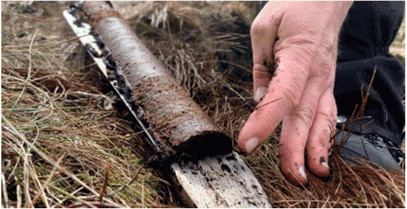
According to the International Union for Conservation of Nature UK (IUCN), 42% of the world's carbon is trapped in stable bog peatlands, with a quarter of Scotland blanketed in peat it is home to some of the finest peat in the world. Some peatland areas are considered so rare and crucial to carbon capture and storage they are currently being considered for World Heritage status.
Each year tonnes of dried, destabilised peat is washed or blown down from the upper peatlands, releasing CO2, and requiring high energy water treatment processes to remove the organic matter during the freshwater treatment process. Stabilising the peatland should dramatically decrease the amount of peat being stripped off the hills and reducing the need to use energy to remove organics matter.
Over the next six years Scottish Water's Sustainable Land Management team will complete the assessment of all catchments. Where restoration work is required, they will negotiate with landowners and stakeholders to agree who will fund and deliver projects.
In 2020/21, 45 hectares of restoration took place, which equates to capturing and storing between 31.5 and 126 tCO2e per year.
Trialling Low Carbon Construction Materials
Scottish Water and its delivery and supply chain partners are actively investigating and trialling low carbon alternatives to traditional construction materials. Examples include smart surfaces and low carbon cement.
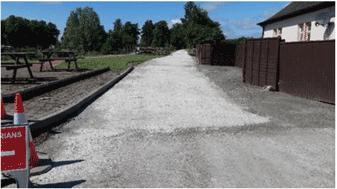
Traditionally, when repairing potholed roads, the existing road surface is dug up and replaced with aggregate which is made up of quarried sand, gravel and rock. Excavating and removing old materials and bringing in new materials (with associated use of transport and heavy plant) all add to the carbon emissions produced.
Mackenzie Construction have come up with a more sustainable solution using a binder to stabilise the existing ground materials. Where sufficient material exists on site it is possible to have zero importation of aggregate and zero off-site disposal of waste, greatly reducing the environmental footprint of projects.
Scottish Water have successfully used this process on the 800-metre access road for Biggar Waste Water Treatment Works in South Lanarkshire.
Concrete is produced by mixing cement with aggregate and water and is the most widely used man-made material in the world with over 17.5 billion tonnes produced each year.
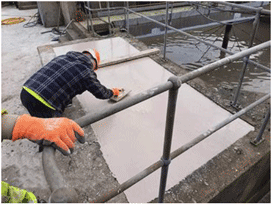
Traditional Old Portland Cement (OPC) is made by heating ground limestone and clay. However, as limestone contains carbon and oxygen, carbon dioxide is released. In fact, for every tonne of cement produced a tonne of carbon dioxide is emitted and cement manufacturing contributes around 8% of global emissions. To reduce the carbon emitted through their capital programme, Scottish Water have started investigating and trialling low carbon concrete alternatives. One of these is a product called 'Cemfree' - Cemfree can be used in place of cement to produce a low carbon concrete with up to 80% less embodied carbon.
Net-zero and economic regulation
For Scottish Water to achieve its emissions targets by 2040, it is vital that it operates, refurbishes and replaces its assets in such a way that looks to minimise the carbon emissions in addition to the financial costs. In its Final Determination, the Water Industry Commission for Scotland (WICS) has set out what it is doing to help allow Scottish Water to achieve this. WICS is moving away from a model of regulation that looks for Scottish Water to minimise costs over the next six-year regulatory control period. It has instead adopted Ethical Business Regulation, which will allow Scottish Water to focus on options that reduce carbon emissions and cost. In addition to this, it is working with Scottish Water while it completes a transformation programme which will enable it to improve its asset appraisals to include carbon, natural and social capital and to put customers views at the heart of its business.
In addition, WICS has established a ring-fenced allowance of £132m to allow Scottish Water to including externalities such as carbon, natural and social capital into its investment appraisals. This fund will cover the extra expenses incurred while Scottish Water broadens its investment appraisals to include the above externalities. This money will be accessible when Scottish Water can evidence that it has selected an option that has a higher net present value when including externalities than the lowest financial cost option that may otherwise have been chosen. This fund will encourage Scottish Water to look at investments which allow it to reduce its carbon emissions and achieve net zero emissions by 2040.
Aqualibrium Low Carbon Heat Scheme
Scottish Water Horizons will launch the latest of its heat from waste water schemes at Aqualibrium in Campbeltown in early 2022.
In partnership with Argyll & Bute Council and Live Argyll, with support from the Scottish Government's Low Carbon Infrastructure Transition Programme, the scheme uses heat from waste water technology to provide low carbon heating to Aqualibrium leisure centre – a rural community-based hub featuring a library, fitness suite and swimming pool.
The new installation works by intercepting waste water from Scottish Water's adjacent Kinloch Park Pumping Station. The technology extracts the naturally occurring residual heat, amplifies it and transfers it to the clean water network to provide heating to the leisure facility.
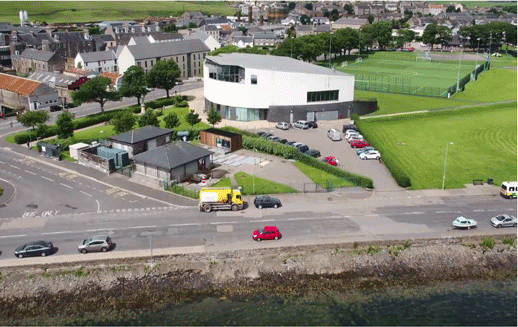
This method of heat generation is a sustainable and affordable alternative to traditional fossil fuels. As the area is not connected to the gas network, compressed gas is delivered to the local community by road tankers. The introduction of the heat from waste water system means that heat will be transported underground, significantly reducing carbon miles. Air quality will also be improved by replacing the need to burn natural gas or other fuel types.
The new heat scheme will supply Aqualibrium with up to 95% of the facility's heating needs. The project builds on previous investment by Scottish Water on a £23million improvement scheme which delivered key infrastructure upgrades to the town in 2012.
BGI - The role of blue-green infrastructure in creating positive living environments
During 2020-21 Citizens Advice Scotland (CAS) commissioned its first piece of research into blue-green infrastructure (BGI). This is a way of designing shared spaces to tackle surface water flooding as well as deliver wider benefits to communities, such as improved access to nature, recreational facilities and improved connectivity in urban spaces.
The research examined practices of local authorities and housing associations in engaging with communities through use of the placemaking principle, to deliver BGI. CAS also undertook a YouGov survey to test public awareness and opinions on how surface water should be managed more sustainably, and to better understand the public's perception of BGI terminology and the extent to which language around BGI, flooding and water management is understood. The key findings from the research found, use of terminology such as 'flooding' could limit community interest in BGI and its wider benefits, to only those impacted by a flood event. Furthermore, lack of consumer understanding around stakeholder roles, and early identification of BGI opportunities in project design and planning, were all likely to impact the success of a project.
Findings from the case studies and the public survey were brought to a virtual stakeholder workshop, which generated the development of positive and practical ideas around the effective delivery of BGI within the sector. Insights from the workshop will inform an insight report, which CAS intends to publish. Further research will be carried out during 2021-22 to better understand and map the developing BGI area, particularly focusing on: stakeholder roles, community engagement in the planning and development of BGI, and barriers to successful implementation of surface water management designs. This will support ongoing development of Scottish policy and strategy as it seeks to implement effective BGI on a wider scale and for greater benefit.
Launch of new asset vesting service to for Scottish developers
Scottish Water Horizons launched a new service earlier on this year to support Scottish Water's efforts to remediate unvested water and waste water assets for the Scottish housing community.
Unvested assets relate to new water or waste water infrastructure which have not met the standards agreed at technical approval stage. As these assets cannot be adopted by Scottish Water, the ownership of the asset sits with the developer who built it; this makes the developer responsible for all operation and maintenance and can carry significant risk – especially if the asset breaks down.
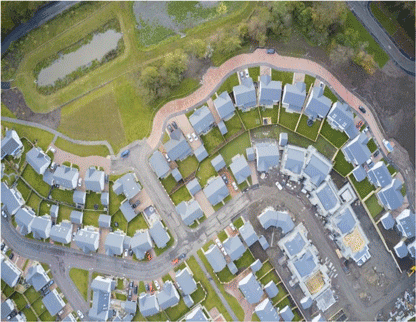
Scottish Water Horizons is tackling this issue by offering an end-to-end remediation service to bring unvested infrastructure up to the correct specification. From complex assets such as pumping stations and Sustainable Urban Drainage Systems (SUDs) to minor works such as raising manhole covers, the company provides consultation and upgrade work to ensure these assets can be safety adopted.
This new service contributes to economic growth by supporting much-needed new housing across Scotland.
Digital water foresighting
Scottish Enterprise (SE) has been carrying out foresighting research into the opportunities for technology and water companies in the digitalisation of the water sector. The pandemic has pushed digital solutions to the forefront to support safe and healthy working, but this has come on the back of an already rising profile for 'digital water' as its benefits are starting to be realised globally.
SE's research has considered the drivers for digitalisation, which include supporting a move to net zero with more efficient use of resources; better operational oversight for improved decision making and customer engagement; and supporting companies to meet regulation and reporting requirements. Barriers to adoption have been identified as cyber security, lack of skills and risk aversion to new technology. The report considers real case studies of digitalisation to help businesses understand water sector opportunities and the benefits and savings that can be achieved.
SE's survey of companies showed that 77% of the 44 respondents stated that digital water is important to their company, with 84% predicting growth in the digital water side of their business within 3 years. The most significant area of digitalisation was within sensors and instrumentation (69%), with one-third working across all aspects (sensors and instrumentation; data, analytics and communications; and networks). Respondents were most likely to work in installation of digitalisation technology (68%) with almost half involved in manufacture (49%), consultancy (49%) and research (46%).
The results showed that there is significant interest in the digitalisation of water from both the water and digital sectors, with expectations for significant growth. The next stage of the foresighting research will cover the technology gaps, focussing on the opportunities for Scottish companies to get involved. If you would like to find out more about this research, please contact Johanna.money@scotent.co.uk.
British Geological Survey
Geoscience solutions are part of the Scottish ambitions for Net Zero. British Geological Survey (BGS) is undertaking research on the critical minerals required for low carbon technologies, such as lithium for batteries and rare earth elements for electronic and motors. The sub surface can also be used for storing energy in the form of compressed air or hydrogen, and is also one of the ways for storing and sequestering excess carbon dioxide (CO2). BGS is investigating the potential for geothermal energy to both heat and cool houses and offices. BGS is also looking at how our landscape can be used to help adapt to climate change, by slowing down flooding and increasing water security.
Hydro Nation Water Innovation Service (HNWIS): Supporting Innovation
Innovation is critical to the health of our water industry and the contribution it makes to the overall economy, driving down costs for consumers and helping to differentiate businesses by developing new processes, technology or materials that are more efficient, effective and cheaper than those they replace. Supporting innovation is a major focus of the Hydro Nation agenda and has been delivered the Hydro Nation Water Innovation Service since 2015.
The most recent service contract for HNWIS has now ended and transitional arrangements are in place to continue to provide support to businesses while a new model is being developed with public sector partners expected to be announced in Spring 2022.
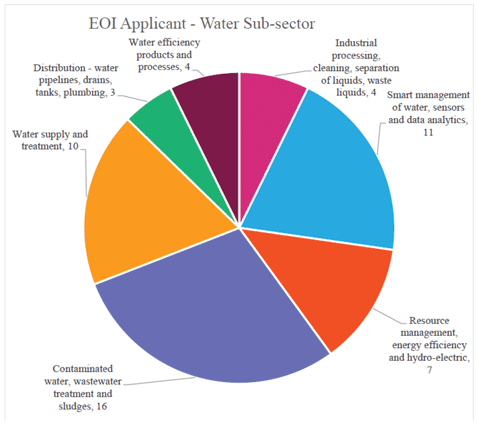
In year 3, HNWIS reported that it engaged almost 300 different companies, exceeding its target of 250. A total of 55 Expression of Interest (EOI)
applications were received. Of these, 26 were referred to a Product Readiness Assessment (PRA) and 6 to Product Trial Support (PTS).
From these referrals 23 undertook the PRA and 5 undertook the PTS. The reduced time to market was difficult to measure but companies who received the support stated that they found it helped their progress to market.
In total, 27 of 55 (~50%) EOI applicants did not receive either package of technical support. This suggests there is an opportunity for Scottish Enterprise (SE) to provide earlier product stage support, or alternatively to extend the length of the service contract to better support companies to a stage where they are ready for technical support. Five applicants took longer than three months to receive technical support, they needed extra support from HNWIS to get them to the stage where they were ready for the technical support.
A summary of progress against objectives is provided below.
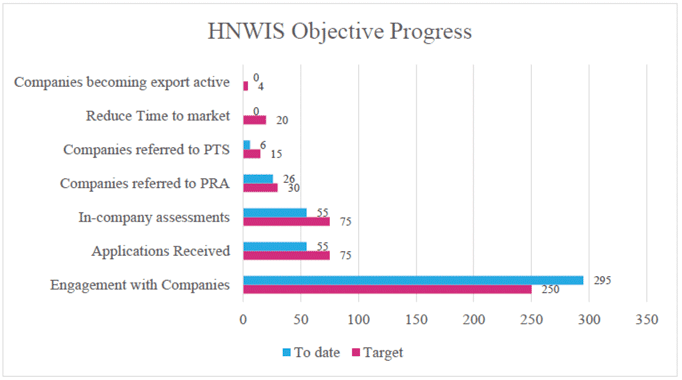
Lessons learned from HNWIS delivery, along with research into wider provision commissioned through CREW have informed thinking on the development of the Scottish Government's next phase of innovation support for the water sector which will launch in the first half of 2022.
Dalmarnock District Heating Network
A £6.1million district heating network has been installed at Clyde Gateway in the east end of Glasgow as part of Scotland's largest regeneration project to date. The new heat network is a partnership between Scottish Water Horizons and Clyde Gateway, with a grant from SP Energy Network's Green Economy Fund. Construction on the project has recently been completed, with customers due to be connected to the new heat system in early 2022.
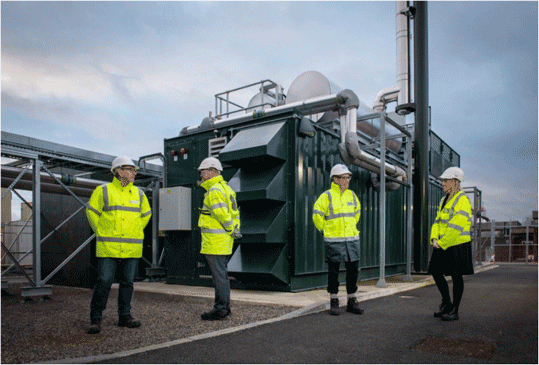
Built on-site at Scottish Water's Dalmarnock Waste Water Treatment Works, the system uses a mix of heat from waste water technology alongside a combined heat and power (CHP) engine to provide instant heat and hot water to homes and office buildings.
The network benefits from two 100kw heat pumps which capture and amplify the natural heat found in waste water. These pumps extract heat energy from the final effluent at the treatment works, adding additional resilience and capacity to the network whilst contributing to the green credentials of the project.
The district heat network has been designed to help tackle fuel poverty in the area, using a metered system that ensures residents and businesses only pay for the energy they use. Costs are reduced thanks to the mix of technologies used, which are significantly more efficient than conventional heating.
One of the main benefits of the project is that it has stimulated investment into a district heat network for the area that should have an asset life in excess of 50 years regardless of the energy source feeding it.
The Clyde Gateway project is a huge undertaking, designated as Scotland's first Green Regeneration and Innovation District. It covers a massive 840 hectares of land across Glasgow and South Lanarkshire, transforming derelict, vacant or polluted spaces into a thriving destination with the aim of tackling inequalities, generating jobs, and ultimately improving lives for the local community.
Contact
Email: waterindustry@gov.scot
There is a problem
Thanks for your feedback